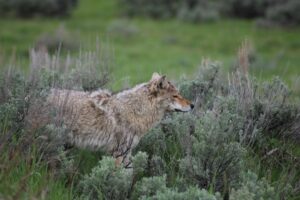Coyote with Mange: Understanding and Treating the Disease
Mange is a skin disease caused by parasitic mites that infest the hair follicles and skin of animals. In coyotes, the most common type of mange is sarcoptic mange, which is caused by the Sarcoptes scabiei mite. This highly contagious disease can spread rapidly through coyote populations, causing severe discomfort and often leading to death if left untreated. The mites burrow into the skin, causing intense itching, hair loss, and skin lesions. As the disease progresses, the coyote’s immune system becomes weakened, making them more susceptible to other infections and diseases. Mange can have a devastating impact on coyote populations, leading to decreased reproductive success and increased mortality rates.
Mange is a zoonotic disease, meaning it can be transmitted from animals to humans. While the risk of contracting mange from coyotes is low, it is still important to exercise caution when coming into contact with infected animals. Mange can also affect domestic dogs, so it is crucial to be aware of the signs and symptoms of the disease in order to protect both wildlife and pets. Understanding the causes, symptoms, and treatment options for mange in coyotes is essential for effective management and conservation efforts.
Key Takeaways
- Mange in coyotes is a skin disease caused by mites that burrow into the skin, leading to hair loss and intense itching.
- Symptoms of mange in coyotes include hair loss, thickened skin, and severe itching, which can lead to secondary infections and a weakened immune system.
- Mange in coyotes is caused by the Sarcoptes scabiei mite, which is highly contagious and can be spread to other animals and even humans.
- Treating mange in coyotes involves administering medication to kill the mites, providing supportive care, and addressing any secondary infections.
- Preventing mange in coyotes involves reducing contact with infected animals, maintaining good hygiene, and managing wildlife populations to prevent overcrowding and stress.
Symptoms of Mange in Coyotes
The symptoms of mange in coyotes are often distressing and can have a significant impact on the animal’s health and well-being. One of the most noticeable signs of mange is hair loss, which typically begins around the face, ears, and elbows before spreading to other parts of the body. As the disease progresses, the coyote’s skin becomes inflamed and crusted, leading to intense itching and discomfort. Infected coyotes may also develop thickened, wrinkled skin and open sores, which can become infected with bacteria. In severe cases, mange can cause emaciation and weakness, making the animal more vulnerable to predation and other threats.
In addition to physical symptoms, mange can also have behavioral effects on coyotes. Infected animals may become more aggressive or display abnormal behavior as a result of their discomfort and weakened condition. They may also become more susceptible to stress and other diseases, further compromising their overall health. Recognizing these symptoms is crucial for early detection and intervention to prevent the spread of mange within coyote populations.
Causes of Mange in Coyotes
Mange in coyotes is caused by infestation with parasitic mites, particularly the Sarcoptes scabiei mite. These microscopic parasites burrow into the skin of the coyote, where they lay eggs and feed on tissue fluids, leading to intense itching and skin irritation. The mites are highly contagious and can be transmitted through direct contact with infected animals or contaminated environments. This means that mange can spread rapidly within coyote populations, especially in areas where animals are in close proximity to one another.
Environmental factors can also play a role in the spread of mange among coyotes. Overcrowding, poor nutrition, and other stressors can weaken the immune systems of coyotes, making them more susceptible to infestation with mites. Additionally, changes in habitat and human activities can increase the risk of transmission between coyotes and other wildlife species. Understanding the causes of mange in coyotes is essential for developing effective management strategies to prevent the spread of the disease and protect vulnerable populations.
How to Treat Mange in Coyotes
| Treatment Method | Description |
|---|---|
| Medicated Shampoo | Using a medicated shampoo specifically designed to treat mange can help kill the mites and soothe the skin. |
| Medication | Veterinarians may prescribe oral or topical medications to help eliminate the mites and reduce inflammation. |
| Environmental Management | Cleaning and disinfecting the coyote’s living area can help prevent re-infestation. |
| Nutritional Support | Providing a balanced diet and supplements can help boost the coyote’s immune system and aid in recovery. |
Treating mange in coyotes can be challenging, especially in wild populations where individual animals may be difficult to capture and handle. However, there are several treatment options available that can help alleviate symptoms and reduce the spread of the disease. One common approach is to use acaricidal medications, which are designed to kill the mites infesting the coyote’s skin. These medications may be administered orally or topically, depending on the severity of the infestation and the availability of resources.
In some cases, it may be necessary to capture infected coyotes for more intensive treatment, such as injections or dips with acaricidal solutions. This approach requires specialized equipment and expertise to ensure the safety of both the animals and the individuals administering treatment. Another important aspect of mange treatment is addressing any secondary infections or complications that may arise as a result of the disease. This may involve providing supportive care, such as antibiotics or wound management, to help infected coyotes recover and regain their health.
Preventing Mange in Coyotes
Preventing mange in coyotes requires a multi-faceted approach that addresses both the direct and underlying causes of the disease. One key strategy is to reduce opportunities for mite transmission by minimizing contact between infected and uninfected animals. This may involve implementing measures to reduce overcrowding and stress in coyote populations, as well as promoting healthy habitats that support strong immune systems in wildlife. Educating the public about the risks of interacting with infected animals and promoting responsible pet ownership can also help prevent the spread of mange between wildlife and domestic animals.
Another important aspect of mange prevention is monitoring and managing wildlife populations to identify and address potential outbreaks early on. This may involve conducting surveys to assess the prevalence of mange in coyote populations and implementing targeted interventions to reduce transmission and support infected animals. Additionally, promoting research into new treatment options and developing vaccines against mange can help improve long-term management efforts and reduce the impact of the disease on coyote populations.
The Impact of Mange on Coyote Populations

Mange can have a significant impact on coyote populations, leading to decreased reproductive success and increased mortality rates. Infected animals may experience reduced fitness due to hair loss, skin lesions, and weakened immune systems, making them more vulnerable to predation and other threats. This can have cascading effects on population dynamics, as decreased survival rates and reproductive output can lead to declines in overall population size.
In addition to direct effects on individual animals, mange can also affect social dynamics within coyote populations. Infected animals may exhibit abnormal behavior or become more aggressive as a result of their discomfort and weakened condition. This can disrupt social structures and interactions within groups, potentially leading to further stress and conflict among individuals.
Seeking Help for Mange-Infected Coyotes
If you encounter a mange-infected coyote or suspect that there may be an outbreak in your area, it is important to seek help from wildlife authorities or conservation organizations. Reporting sightings of infected animals can help experts track the spread of mange and implement targeted interventions to support affected populations. Additionally, seeking assistance from professionals with experience in wildlife management and disease control can help ensure that infected animals receive appropriate care and treatment.
It is important to remember that mange-infected coyotes are wild animals and should be approached with caution. Attempting to capture or handle infected animals without proper training and equipment can be dangerous for both humans and wildlife. Instead, focus on providing information to relevant authorities so that they can take appropriate action to address the situation.
In conclusion, mange is a serious threat to coyote populations and requires careful management to prevent its spread and minimize its impact on wildlife. By understanding the causes, symptoms, treatment options, and prevention strategies for mange in coyotes, we can work towards protecting these iconic animals from this debilitating disease. Collaboration between wildlife authorities, conservation organizations, and the public is essential for effective management efforts that support healthy coyote populations for future generations.
If you’re interested in learning more about the impact of mange on wildlife, check out this informative article on Get Outside Map. The article discusses the effects of mange on coyotes and other wildlife populations, and offers insights into how this disease can affect ecosystems. It’s a fascinating read for anyone interested in wildlife conservation and the challenges faced by animals in the wild. Get Outside Map is a great resource for outdoor enthusiasts and nature lovers alike.
FAQs
What is mange in coyotes?
Mange is a skin disease caused by mites that burrow into the skin, causing irritation, hair loss, and scabbing. In coyotes, the most common type of mange is sarcoptic mange, caused by the Sarcoptes scabiei mite.
How do coyotes get mange?
Coyotes can get mange through direct contact with an infected animal or contaminated environment. The mites that cause mange are highly contagious and can spread easily among coyote populations.
What are the symptoms of mange in coyotes?
Symptoms of mange in coyotes include hair loss, scabbing, thickened skin, and intense itching. Infected coyotes may appear weak, emaciated, and have a scruffy or unkempt appearance.
Is mange in coyotes a threat to humans?
The mites that cause mange in coyotes can infest humans, causing a temporary skin irritation known as “scabies.” However, direct transmission from coyotes to humans is rare, and proper hygiene and avoidance of contact with infected animals can prevent the spread of the mites.
How is mange in coyotes treated?
Mange in coyotes can be treated with medication, such as antiparasitic drugs, to kill the mites and alleviate symptoms. In severe cases, infected coyotes may require veterinary care and supportive treatment to recover.
Can coyotes with mange recover?
With proper treatment, coyotes with mange can recover and regain their health. However, severe cases of mange can be fatal, especially if the coyote is already weakened by other factors such as malnutrition or injury.














Post Comment
You must be logged in to post a comment.